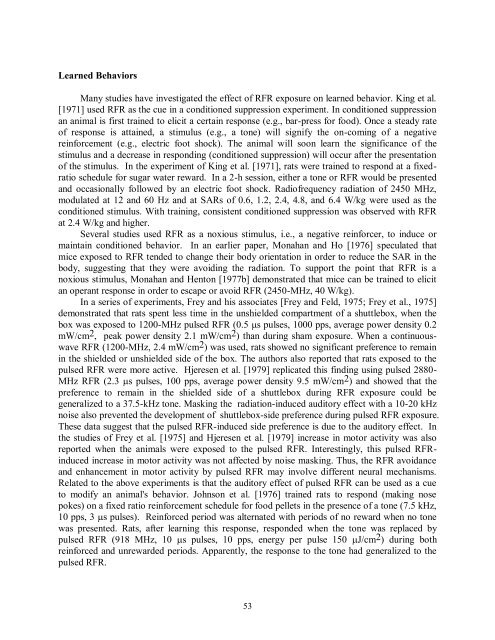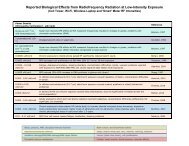Evidence for Effects on Neurology and Behavior - BioInitiative Report
Evidence for Effects on Neurology and Behavior - BioInitiative Report
Evidence for Effects on Neurology and Behavior - BioInitiative Report
Create successful ePaper yourself
Turn your PDF publications into a flip-book with our unique Google optimized e-Paper software.
Learned <strong>Behavior</strong>s<br />
Many studies have investigated the effect of RFR exposure <strong>on</strong> learned behavior. King et al.<br />
[1971] used RFR as the cue in a c<strong>on</strong>diti<strong>on</strong>ed suppressi<strong>on</strong> experiment. In c<strong>on</strong>diti<strong>on</strong>ed suppressi<strong>on</strong><br />
an animal is first trained to elicit a certain resp<strong>on</strong>se (e.g., bar-press <str<strong>on</strong>g>for</str<strong>on</strong>g> food). Once a steady rate<br />
of resp<strong>on</strong>se is attained, a stimulus (e.g., a t<strong>on</strong>e) will signify the <strong>on</strong>-coming of a negative<br />
rein<str<strong>on</strong>g>for</str<strong>on</strong>g>cement (e.g., electric foot shock). The animal will so<strong>on</strong> learn the significance of the<br />
stimulus <strong>and</strong> a decrease in resp<strong>on</strong>ding (c<strong>on</strong>diti<strong>on</strong>ed suppressi<strong>on</strong>) will occur after the presentati<strong>on</strong><br />
of the stimulus. In the experiment of King et al. [1971], rats were trained to resp<strong>on</strong>d at a fixedratio<br />
schedule <str<strong>on</strong>g>for</str<strong>on</strong>g> sugar water reward. In a 2-h sessi<strong>on</strong>, either a t<strong>on</strong>e or RFR would be presented<br />
<strong>and</strong> occasi<strong>on</strong>ally followed by an electric foot shock. Radiofrequency radiati<strong>on</strong> of 2450 MHz,<br />
modulated at 12 <strong>and</strong> 60 Hz <strong>and</strong> at SARs of 0.6, 1.2, 2.4, 4.8, <strong>and</strong> 6.4 W/kg were used as the<br />
c<strong>on</strong>diti<strong>on</strong>ed stimulus. With training, c<strong>on</strong>sistent c<strong>on</strong>diti<strong>on</strong>ed suppressi<strong>on</strong> was observed with RFR<br />
at 2.4 W/kg <strong>and</strong> higher.<br />
Several studies used RFR as a noxious stimulus, i.e., a negative rein<str<strong>on</strong>g>for</str<strong>on</strong>g>cer, to induce or<br />
maintain c<strong>on</strong>diti<strong>on</strong>ed behavior. In an earlier paper, M<strong>on</strong>ahan <strong>and</strong> Ho [1976] speculated that<br />
mice exposed to RFR tended to change their body orientati<strong>on</strong> in order to reduce the SAR in the<br />
body, suggesting that they were avoiding the radiati<strong>on</strong>. To support the point that RFR is a<br />
noxious stimulus, M<strong>on</strong>ahan <strong>and</strong> Hent<strong>on</strong> [1977b] dem<strong>on</strong>strated that mice can be trained to elicit<br />
an operant resp<strong>on</strong>se in order to escape or avoid RFR (2450-MHz, 40 W/kg).<br />
In a series of experiments, Frey <strong>and</strong> his associates [Frey <strong>and</strong> Feld, 1975; Frey et al., 1975]<br />
dem<strong>on</strong>strated that rats spent less time in the unshielded compartment of a shuttlebox, when the<br />
box was exposed to 1200-MHz pulsed RFR (0.5 s pulses, 1000 pps, average power density 0.2<br />
mW/cm 2 , peak power density 2.1 mW/cm 2 ) than during sham exposure. When a c<strong>on</strong>tinuouswave<br />
RFR (1200-MHz, 2.4 mW/cm 2 ) was used, rats showed no significant preference to remain<br />
in the shielded or unshielded side of the box. The authors also reported that rats exposed to the<br />
pulsed RFR were more active. Hjeresen et al. [1979] replicated this finding using pulsed 2880-<br />
MHz RFR (2.3 s pulses, 100 pps, average power density 9.5 mW/cm 2 ) <strong>and</strong> showed that the<br />
preference to remain in the shielded side of a shuttlebox during RFR exposure could be<br />
generalized to a 37.5-kHz t<strong>on</strong>e. Masking the radiati<strong>on</strong>-induced auditory effect with a 10-20 kHz<br />
noise also prevented the development of shuttlebox-side preference during pulsed RFR exposure.<br />
These data suggest that the pulsed RFR-induced side preference is due to the auditory effect. In<br />
the studies of Frey et al. [1975] <strong>and</strong> Hjeresen et al. [1979] increase in motor activity was also<br />
reported when the animals were exposed to the pulsed RFR. Interestingly, this pulsed RFRinduced<br />
increase in motor activity was not affected by noise masking. Thus, the RFR avoidance<br />
<strong>and</strong> enhancement in motor activity by pulsed RFR may involve different neural mechanisms.<br />
Related to the above experiments is that the auditory effect of pulsed RFR can be used as a cue<br />
to modify an animal's behavior. Johns<strong>on</strong> et al. [1976] trained rats to resp<strong>on</strong>d (making nose<br />
pokes) <strong>on</strong> a fixed ratio rein<str<strong>on</strong>g>for</str<strong>on</strong>g>cement schedule <str<strong>on</strong>g>for</str<strong>on</strong>g> food pellets in the presence of a t<strong>on</strong>e (7.5 kHz,<br />
10 pps, 3 s pulses). Rein<str<strong>on</strong>g>for</str<strong>on</strong>g>ced period was alternated with periods of no reward when no t<strong>on</strong>e<br />
was presented. Rats, after learning this resp<strong>on</strong>se, resp<strong>on</strong>ded when the t<strong>on</strong>e was replaced by<br />
pulsed RFR (918 MHz, 10 s pulses, 10 pps, energy per pulse 150 J/cm 2 ) during both<br />
rein<str<strong>on</strong>g>for</str<strong>on</strong>g>ced <strong>and</strong> unrewarded periods. Apparently, the resp<strong>on</strong>se to the t<strong>on</strong>e had generalized to the<br />
pulsed RFR.<br />
53



